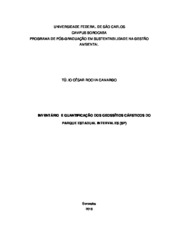| dc.contributor.author | Camargo, Túlio César Rocha | |
| dc.date.accessioned | 2018-05-21T17:51:24Z | |
| dc.date.available | 2018-05-21T17:51:24Z | |
| dc.date.issued | 2018-02-06 | |
| dc.identifier.citation | CAMARGO, Túlio César Rocha. Inventário e quantificação dos geossítios cársticos do Parque Estadual Intervales (SP). 2018. Dissertação (Mestrado em Sustentabilidade na Gestão Ambiental) – Universidade Federal de São Carlos, Sorocaba, 2018. Disponível em: https://repositorio.ufscar.br/handle/ufscar/10083. | * |
| dc.identifier.uri | https://repositorio.ufscar.br/handle/ufscar/10083 | |
| dc.description.abstract | The increase in public use in natural areas in the last decades is characterized by the interest of knowing and contemplating the natural patrimony, constituted by elements of bio and geodiversity - the latter being the focus of this research. One of the representative elements of geodiversity is classified as geosite. In karstic terrain, caves are common examples of geosites, as long as they have some dimension of intrinsic value or even of use for science, conservation, tourism, or education. In this context the objective of this research was to analyze the karstic geosites of the State Park Intervales (SPI), making possible their quantification and valuation. The methods used were based on bibliographical research and field work to identify, characterize, inventory and evaluate selected geosites, whether or not open to public use, outside and inside of this Natural Protected Area (NPA). The main results demonstrated the categorization of each geosite from its values: intrinsic, scientific, tourist, use / management and educational, which was the new dimension of analysis. Through the synthesis of these values, the results of the quantification were applied in equations to measure the categories of geosites for each type of use: scientific, tourism and proposed tourist-educational. In the end, it was calculated and compared the Ranking of Traditional Relevance (TR) and Ranking of Proposed Relevance (PR) of each geosite, revealing that some caves have a high tourist value, due to the large number of visits and activity carried out with elementary schools, high school, undergraduate and postgraduate, a considerable scientific value in the representativeness of geological processes, variety of elements of bio and geodiversity as well as a high educational value. It is concluded that the inventory and quantification of geosites can serve as a tool for the expansion of strategies for geoconservation, through activities that correspond to the characteristics of each geosite, both at the regional and national levels. Considering that educational tourism and speleotourism are already activities developed in and around the SPI and a source of income for the local communities, it is also expected that the work will disseminate the geotourism potential of the area, based on a future strategy of geotourism and geoconservation. | eng |
| dc.description.sponsorship | Não recebi financiamento | por |
| dc.language.iso | por | por |
| dc.publisher | Universidade Federal de São Carlos | por |
| dc.rights.uri | Acesso aberto | por |
| dc.subject | Unidade de Conservação | por |
| dc.subject | Geoconservação | por |
| dc.subject | Geodiversidade Cárstica | por |
| dc.subject | Conservation Unit | eng |
| dc.subject | Geoconservation | eng |
| dc.subject | Karstic Geodiversity | eng |
| dc.subject | Value of Educational Use | eng |
| dc.subject | Valor de Uso Educacional | por |
| dc.subject | Valor del uso educativo | esp |
| dc.subject | Unidad de Conservación | esp |
| dc.subject | Geoconservación | esp |
| dc.subject | Geodiversidad Karstica | esp |
| dc.title | Inventário e quantificação dos geossítios cársticos do Parque Estadual Intervales (SP) | por |
| dc.title.alternative | Inventory and quantification of the cavestic geosytes of the Intervales State Park (SP) | eng |
| dc.type | Dissertação | por |
| dc.contributor.advisor1 | Lobo, Heros Augusto Lobo | |
| dc.contributor.advisor1Lattes | http://lattes.cnpq.br/9405961078398915 | por |
| dc.description.resumo | O aumento do uso público em áreas naturais nas últimas décadas se caracteriza pelo interesse de conhecer e contemplar o patrimônio natural, constituído por elementos da bio e geodiversidade – esta última, foco desta pesquisa. Um dos elementos representativos da geodiversidade são classificados como geossítios. Em terrenos cársticos, cavernas são exemplos comuns de geossítios, desde que possuam alguma dimensão de valor intrínseco ou mesmo de uso para a ciência, conservação, turismo ou educação. Nesse contexto o objetivo desta pesquisa foi analisar 16 geossítios cársticos do Parque Estadual Intervales (PEI), possibilitando sua quantificação e valoração. Os métodos empregados foram baseados em pesquisas bibliográficas e trabalho de campo para identificação, caracterização, inventário e valoração dos geossítios selecionados, abertos ou não ao uso público, fora e dentro da Unidade de Conservação (UC). Os principais resultados demonstraram a categorização de cada geossítio a partir de seus valores: intrínseco, cientifico, turístico, uso/gestão e o educacional, que foi a nova dimensão de análise. Através da síntese desses valores, os resultados da quantificação foram aplicados em equações para mensurar as categorias dos geossítios para cada tipo de uso: cientifico, turístico e o proposto turístico-educacional. No final foi calculado e comparado o Ranking de Relevância Tradicional (RT) e Ranking de Relevância Proposto (RP) de cada geossítio, revelando que algumas cavernas possuem um elevado valor turístico, o que se evidencia na prática pelo grande número de visitações e atividade realizadas com escolas de ensino fundamental, ensino médio, graduação e pós-graduação; um valor científico considerável na representatividade de processos geológicos, variedade de elementos da bio e geodiversidade bem como um valor educacional elevado. Conclui-se que o inventário e quantificação de geossítios pode servir como ferramenta para a ampliação de estratégias para a geoconservação, através de atividades que correspondam com a característica de cada geossítio, tanto em âmbito regional quanto nacional. Considerando que o turismo educacional e o espeleoturismo já são atividades desenvolvidas no PEI e em seu entorno, e fonte de renda para as comunidades locais, espera-se também que o trabalho divulgue o potencial geoturístico da área, servindo de base para uma futura estratégia de geoturismo e geoconservação. | por |
| dc.publisher.initials | UFSCar | por |
| dc.publisher.program | Programa de Pós-Graduação em Sustentabilidade na Gestão Ambiental - PPGSGA-So | por |
| dc.subject.cnpq | CIENCIAS EXATAS E DA TERRA::GEOCIENCIAS | por |
| dc.ufscar.embargo | Online | por |
| dc.publisher.address | Câmpus Sorocaba | por |
| dc.contributor.authorlattes | http://lattes.cnpq.br/7229494839342677 | por |

